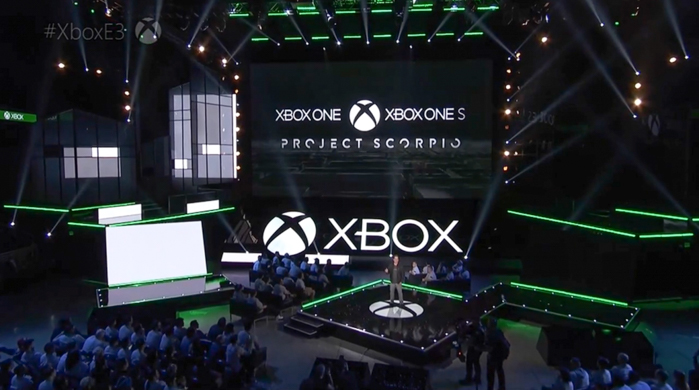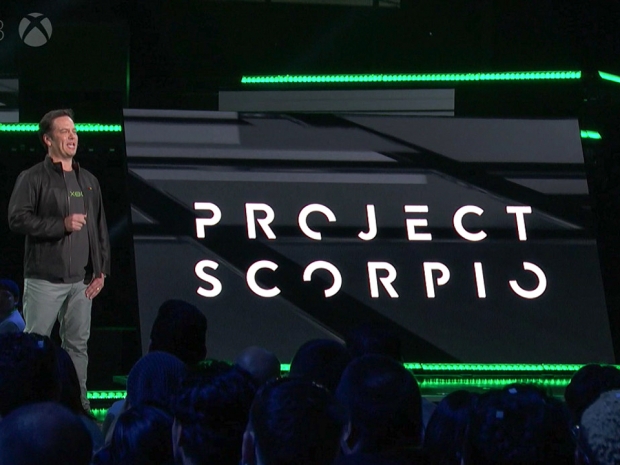At its E3 keynote, the company revealed some elements of its new product roadmap, codenamed “Project Scorpio,” suggesting that the device will come packed with teraflops and compute power never previously witnessed by the console market.
 Image credit: WindowsCentral.com
Image credit: WindowsCentral.com
Microsoft is calling its next-generation console project an “uncompromising gaming machine” packed with 4K video output at 60fps, VR support, an 8-core AMD CPU and over 320GB/s of memory bandwidth. This puts total system bandwidth right on par with Nvidia’s Geforce GTX 1080, which uses GDDR5X memory on a 256-bit wide bus. To top it all off, Microsoft says Project Scorpio will exceed 6-teraflops of compute performance, or the equivalent of over three PS4s (1.84 teraflops each) all packed into a single box.
Reaching beyond 6-teraflops in a console
According to AnandTech, the current Xbox One gets a peak shader throughput of 1.23 teraflops using an 8-core 28nm AMD Jaguar APU, 768 cores on the GPU and 1400MHz GDDR3 memory. Meanwhile, the PS4 reaches 1.84 teraflops using the same CPU but with 1152 cores on the GPU and 8GB of 5500MHz GDDR5. The difference is that Microsoft chose AMD’s 12 compute unit GPU configuration with 68.3GB/s system memory bandwidth (102GB/s embedded bandwidth), while Sony chose an 18 compute unit configuration with 176GB/s system memory bandwidth.
But with neither current-generation console peaking above 2-teraflops, Microsoft wants to raise the bar over three-fold by putting Project Scorpio above the 6-teraflops line. For comparison, one of AMD’s recent 14nm GPUs, the Radeon RX 480, peaks above 5-teraflops for $229 in an 8GB GDDR5 configuration at 256GB/s memory bandwidth. One of Nvidia’s latest 16nm GPUs, the Geforce GTX 1070, peaks around 5.78-teraflops for $379 in an 8GB GDDR5 configuration at 256GB/s memory bandwidth.
AMD is not giving hints on custom APU silicon
Earlier today, AMD sent out a note to members of the press saying they are not providing additional information regarding the AMD semi-custom silicon in either Xbox One S or Project Scorpio at this time.
“We are proud that Microsoft has chosen to expand their Xbox One family of devices with two new consoles featuring AMD’s high-performance semi-custom SoCs that support revolutionary new technologies like HDR, 4K and high fidelity VR to enable the next generation of immersive gaming experiences.”
Currently, there are a variety of custom solutions that come to mind for potentially peaking 6-teraflops. One rather expensive option would be to use a custom version of AMD’s upcoming Zen APU with Greenland stream processor, which we mentioned in April 2015. This enterprise-grade APU uses clusters of four Zen cores sharing 8MB of L3 cache and supports High Bandwidth Memory (HBM) up to 512GB/s. Microsoft could use a two-cluster, 8-core Zen chip and pair it with Greenland (also known as Vega 10), but the biggest problem with this approach is cost. High Bandwidth Memory does not come cheap and Microsoft is known for avoiding unnecessary costs when evaluating platform lifecycles.
A more ideal solution might be to pair an 8-core Zen chip with a custom low-power Polaris GPU with finer-grained control over asynchronous compute tasks. The solution may feature additional dedicated interconnects between the Zen die and graphics core, similar to what AMD accomplished in the PS4.
Whatever the case may be, AMD knows it has some very important quarters ahead of its Radeon and CPU departments, and the results may shape its partnership with Microsoft beyond the scope of only console gaming for quite some time.

